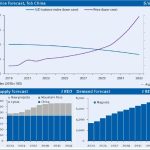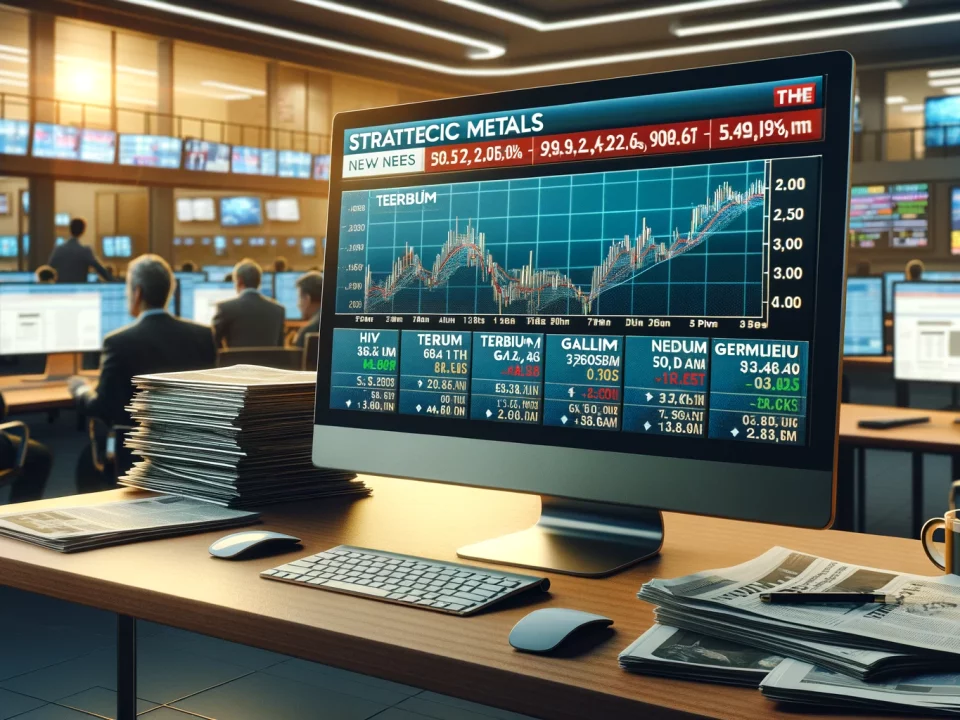
Weekly News Review Apr 8 – Apr 14 2024
April 14, 2024
10-Year Demand, Supply, and Price Forecasts for Dysprosium, Praseodymium, Neodymium, and Terbium
April 24, 2024Welcome to our weekly news review.
STRATEGIC METALS: CANADA EXPANDS SUPPLY CHAIN –
From 2025, raw materials from Vietnam will be processed in Canada. At the same time, cooperation with France is being expanded.
A rare earths processing plant is being built in the Canadian province of Saskatchewan. It would be the first domestic plant and one of the few outside of the raw materials giant China. As early as next year, raw materials from Vietnam, which aims to become a significant producer of rare earths, will be processed there. The plant’s operator, the government-funded research and technology organization Saskatchewan Research Council (SRC), signed an agreement with the Vietnamese Hung Thinh Group (HTG) on Monday.
From June 2025 to 2030, up to 3,000 tons of rare earth carbonate will be supplied annually, enough to produce about 400 tons of rare earth metal annually. The critical raw materials are essential for numerous green and digital technologies. The plant’s construction has recently received millions in funding from various government agencies. It is expected to act as a catalyst for the resource sector across Canada and strengthen the midstream supply chain.
CANADA AND FRANCE AS TRADING PARTNERS –
At the same time, the Government of Saskatchewan announced that it had signed a Memorandum of Understanding with France to develop supply chains for strategic minerals. The focus is on sustainable, secure supply chains, research into critical minerals, and the common goal of reducing greenhouse gas emissions. While resource-rich Canada wants to establish itself as a leading producer of raw materials, France is home to one of the few rare earth plants in Europe, operated by the chemical group Solvay.
As reported, the processing plant will be expanded to strengthen the European value chain for permanent magnets made from rare earths. Almost 100 percent of these components, essential for electric motors and wind power, are currently imported into the EU from China.
STRATEGIC METALS: US BLOCKS ROAD-ACCESS-PROJECT CITING ENVIRONMENTAL CONCERNS –
The Ambler Road project in Alaska would give access to zinc, copper, gold, and rare earth deposits.
The United States Government is set to block a road project in the northern state of Alaska, which would open up numerous deposits of critical minerals and raw materials such as zinc, copper, gold, and possibly rare earth elements, according to Politico, which cites people with knowledge of the decision. The Ambler Road project is a proposed 211-mile (340 kilometers) long roadway on the south side of the Brooks Range, a mountain range in northern Alaska stretching into Canada’s Yukon Territory. The road would be open only to mining-related traffic and remain closed to the public, providing access to otherwise inaccessible mineral deposits.
According to Trilogy Metals, a company seeking to develop a mineral deposit in the region, metals hosted within the mountain range include copper, zinc, gold, lead, and silver. The Alaska Department of Natural Resources report added rare earth elements and platinum group metals to the list.
DIFFICULT BALANCING ACT –
The Bureau of Land Management (BLM), part of the US Department of the Interior, stated that these deposits would likely remain unexploited without the infrastructure project. Despite the economic benefits, the road would significantly interfere with remote regions that are otherwise untouched, underlining the difficult balancing act policymakers face globally in the search for critical minerals.
Renewable energies and modern technologies rely on a steady supply of critical minerals, but mining them presents environmental hurdles. Reports by consultancy EY argue that the global energy transition to renewable energies will only happen when mining activities ramp up. On the other hand, local residents have environmental concerns and resistance, for example, in the case of the rare earth projects Matamulas in Spain or Norra Kärr in Sweden.
Local resistance exists in the Ambler Road case, too, but not exclusively, as Alaskan lawmakers lobbied the Biden Administration to allow the road to be built. Politico writes that a president’s rejection would likely be challenged by the state agency overseeing the project, adding that this would “infuriate” the lawmakers of the northernmost US state.
MINING MAGNATE INVESTS IN RARE EARTHS:
New impetus for speculation about a merger between MP Materials (USA) and Lynas Corp.(Australia).
Australian mining billionaire Gina Rinehart is pushing ahead with the diversification of her company, Hancock Prospecting. The group, which originates in mining iron ore, increased its stake in rare earth specialist Lynas to just under six percent this week, as detailed in a press release. A few days ago, Rinehart had already invested in the most critical US company in the industry and acquired a stake of more than five percent in MP Materials.
In February, rumors circulated about a possible merger between MP Materials and Lynas, which could counter China’s market power in the rare earths sector.
According to Lynas, there have indeed been talks about this, but they are currently on hold. However, Rinehart’s investment in both companies has now given new impetus to speculation about a connection, as Bloomberg, among others, writes.
Hancock Prospecting also holds shares in the Australian company Arafura Rare Earths, planning to build the first combined mine and processing plant for rare earths in Australia. The company is also investing in projects to extract these critical raw materials in Brazil.
In addition, Rinehart is increasingly investing in companies specializing in lithium mining, such as Vulcan Energy Resources. The company plans to extract the battery metal from the deep saline waters of the Upper Rhine Graben.
STRATEGIC METALS SUPPLY: ROLAND BERGER ADVISES SWIFT ACTION –
No energy transition without critical raw materials: A new study by consultancy Roland Berger examines the importance of rare earths, lithium, nickel, and cobalt and the difficulty securing their supply. In the case of the latter three resources, supply is likely only to be able to keep pace with demand until 2030. The report continues that although the raw material deposits are available, there is a considerable risk in developing new mines and expanding refinery capacities.
Other challenges include a shortage of skilled workers and uncertainties regarding the growth in demand, for example, in the EV industry. Disruptive technologies, i.e., those that completely reshape the market, are also a risk factor. Here, Roland Berger mentions the controversial deep-sea mining, which could lead to a significantly more significant supply of nickel, among other things.
The consultancy firm advises that the supply chains for critical raw materials should be secured quickly. To do so, the supply streams must first be fully understood. Therefore, access to market information is essential to gain a competitive advantage, especially in times of crisis.
US FIRM FIRST SOLAR PARTNERS WITH GERMAN RESEARCH INSTITUTE:
The cooperation focuses on advancing the performance and scale of thin film photovoltaics.
U.S.-based First Solar, the largest solar module manufacturer outside China, has signed a strategic research partnership with the German research institute Zentrum für Sonnenenergie- und Wasserstoff-Forschung Baden-Württemberg (ZSW) to advance thin-film photovoltaics.
According to a press statement, the cooperation will focus on advancing the performance of thin film photovoltaics and the potential to develop and optimize tandem technologies on a gigawatt scale. Tandem or multi-junction solar cells combine two or more photovoltaic absorbers, each with different properties, which utilizes the sun’s spectrum more efficiently.
ZSW’s research fields extend beyond solar to lithium-ion batteries and fuel cells, for example, and it has been advising the German Government in these fields for over thirty years.
In 2022, First Solar announced a massive investment of over one billion dollars to expand its thin-film production in the United States.
In addition, the company has continuously expanded its portfolio, for example, by acquiring the Swedish copper indium gallium selenide (CIGS) industry company Evolar. Evolar specializes in thin films made from perovskite, a mineral group used in the construction of tandem cells.
However, the main ingredient First Solar relies on for its thin-film modules is cadmium telluride. The semiconductor material can generate energy in dim sunlight and under high temperatures, but its efficiency is lower than that of widely used silicon-based modules.
CANADIAN MINING GROUP NIOCORP EYES RARE EARTH RECYCLING:
Canadian mining group plans feasibility study for its Elk Creek project in the US.
The Canadian mining group NioCorp wants to mine and process niobium, titanium, and rare earths as part of its Elk Creek project in the state of Nebraska in the US. A feasibility study is now being conducted to show whether the recycling of rare earth permanent magnets would also be economical. The company said the planned production of neodymium, praseodymium, dysprosium, and terbium oxide in Elk Creek could thus be expanded.
The demand for these raw materials is increasing, primarily due to their importance for electromobility and wind power; the supply of so-called heavy rare earths such as terbium and dysprosium, which are more challenging to extract and have so far only been mined in China and Myanmar, is considered particularly critical. The process flow developed for Elk Creek can be adapted to the recycling of rare earths without significant changes, said Scott Honan, Chief Operating Officer of NioCorp
With the growing demand for critical minerals, recycling could become an increasingly important source of raw materials.
Other companies along the value chain, such as the Australian mining group Ionic Rare Earths and German magnet manufacturer Vacuumschmelze, are also expanding their recycling business areas.
In addition, numerous government support measures are aimed at the circular economy; the US, for example, wants to expand the extraction of raw materials from wastewater.






